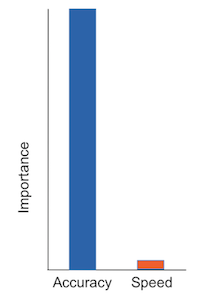Subnetting Learning Stage 2: Perfecting
To learn subnetting more efficiently, and be better prepared for the exam, you need a metaphorical push out of the nest from momma bird. That’s learning stage 2. Today’s post goes beyond the metaphor to discuss the kinds of advice I give students in the IPv4 Subnetting course at Safari. Next post looks at stage 3: Accelerating.
Quick Links: Earlier Posts on Subnetting Learning Stages:
Stage 2: Perfecting – Self-Evaluation
When I was a kid, we dreaded hearing the teacher say, “Clear Your Desks!” to announce it was time for a test. (Teachers must have had a club where they made sure to use the same torture tools on the kids in the school.)
Continue to re-evaluate your learning stage, no matter which branch of subnetting you are learning and no matter your current learning stage. When you self-evaluate, you reach stage 2 when you can clear your desk of all notes about a subnetting branch and still do the math. That is:
- Without notes…
- Given all the time you need to take…
- You can perform the math…
- And you do NOT yet have to get 100% correct.
At this stage, you understand and remember enough to do the work, but you just need more practice to reach the point that you get the correct answers all the time.
Stage 2: Perfecting – Study Advice
You should stop using your notes now. Forcing yourself to move on to doing your practice without notes will help you keep improving your memory and mastery of that part of subnetting. Instead, focus on doing the tasks from memory, taking all the time you need, focusing on improving your accuracy to 100%. But ignore your speed for now.

Figure 4: Priorities at Stage 2
At stage 2, you should be following this kind of an approach:
- Clear Your Desk! Before each time you practice, put away all notes.
- If you plan to write notes on exam day before the exam timer starts (e.g., writing the powers of 2 on your note page), practice that every time you start a new practice session.
- Do a practice problem set of 5-to-10 problems:
- Do the entire set of questions before checking the answers.
- For any that you missed, figure out why.
- Time/Speed
- Do not even track how much time you took.
- Take all the time you need.
Let me point out a few reasons for some of the approaches listed above. First, if you plan to take notes once you are sitting at the exam, you should practice writing those notes! Do not skip that activity! Second, waiting to check your answers until you complete a set of practice problems helps you begin to trust yourself and trust the process you have learned. Often people learn the process but then do not believe the process worked when the question uses unexpected values. Trust the process! Finally, allow yourself to ignore speed at this point, and do not be worried about going slow. Keep your focus on learning how to get the correct answer every time.
Continue to evaluate your stage! Over time, you should get to the point at which you get entire sets of 5-10 problems correct, and be confident you got them all correct before you move on to stage 3.
Are You at Stage 2 (Perfecting) for Any of These?
Where are you right now? Stage 2 for any of the below subnetting branches (as per my subnetting course)? Post here or tweet me (@WendellOdom) with #IPSubnetting.
| Subnetting Processes Described | Shortname | Stage 1? |
| Classful Networks: Find Key Facts * | Network Facts | |
| Converting Subnet Mask Formats * | Convert Masks | |
| From Address/Mask, Find Subnet ID, Broadcast Address, and Address Range | Subnet Facts | |
| Interpret Design Based on Mask to Predict # Subnets, # Hosts/Subnet | Interpret Mask | |
| Based on Design Criteria, Choose 1 Mask | Choose Mask | |
| For Network w/ 1 Mask, Find All Subnet IDs | Find Subnets |
